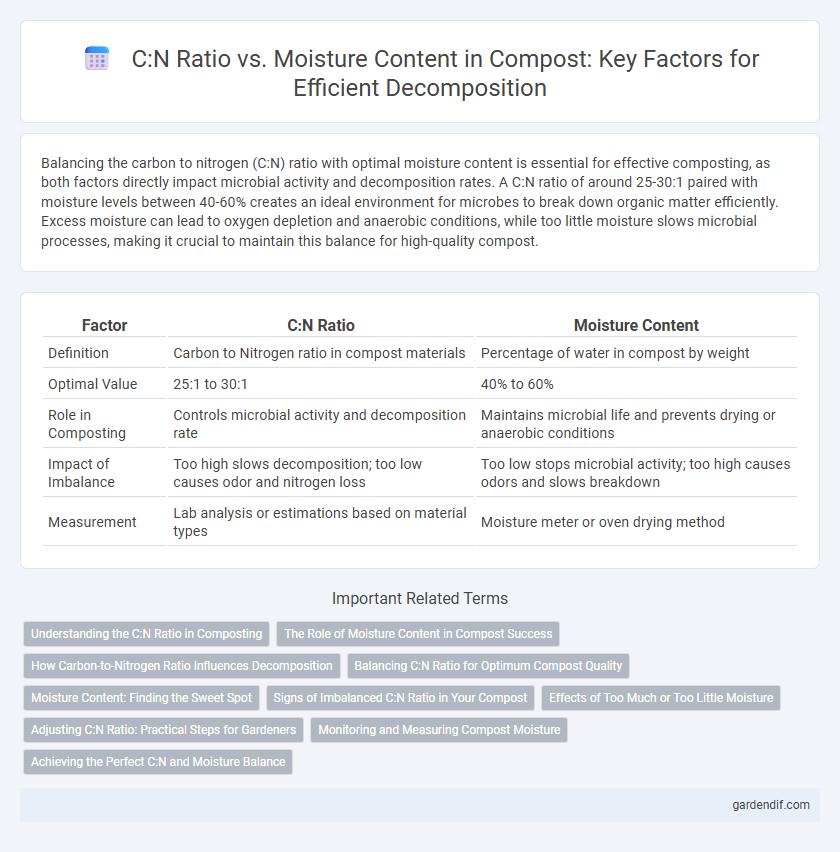
C:N Ratio vs Moisture Content Illustration
Balancing the carbon to nitrogen (C:N) ratio with optimal moisture content is essential for effective composting, as both factors directly impact microbial activity and decomposition rates. A C:N ratio of around 25-30:1 paired with moisture levels between 40-60% creates an ideal environment for microbes to break down organic matter efficiently. Excess moisture can lead to oxygen depletion and anaerobic conditions, while too little moisture slows microbial processes, making it crucial to maintain this balance for high-quality compost.
Table of Comparison
| Factor | C:N Ratio | Moisture Content |
|---|---|---|
| Definition | Carbon to Nitrogen ratio in compost materials | Percentage of water in compost by weight |
| Optimal Value | 25:1 to 30:1 | 40% to 60% |
| Role in Composting | Controls microbial activity and decomposition rate | Maintains microbial life and prevents drying or anaerobic conditions |
| Impact of Imbalance | Too high slows decomposition; too low causes odor and nitrogen loss | Too low stops microbial activity; too high causes odors and slows breakdown |
| Measurement | Lab analysis or estimations based on material types | Moisture meter or oven drying method |
Understanding the C:N Ratio in Composting
The carbon-to-nitrogen (C:N) ratio is a crucial parameter in composting that affects microbial activity and decomposition rates. Ideal C:N ratios range from 25:1 to 30:1, balancing carbon-rich materials like dry leaves with nitrogen-rich materials such as kitchen scraps to optimize moisture retention and microbial metabolism. Maintaining proper moisture content between 40% to 60% ensures nutrient availability, supports microbial growth, and prevents anaerobic conditions that disrupt efficient composting.
The Role of Moisture Content in Compost Success
Moisture content is critical for maintaining an optimal C:N ratio during composting, ensuring microbial activity and efficient organic matter breakdown. Proper moisture levels, typically between 40-60%, facilitate nutrient balance by enabling microbes to access carbon and nitrogen compounds effectively. Insufficient or excessive moisture disrupts this balance, hindering decomposition and leading to odor or slow compost maturation.
How Carbon-to-Nitrogen Ratio Influences Decomposition
The carbon-to-nitrogen (C:N) ratio is a critical factor in compost decomposition, influencing microbial activity and nutrient availability. Optimal decomposition occurs when the C:N ratio ranges between 25:1 and 30:1, as this balance provides sufficient carbon for energy and nitrogen for protein synthesis. Excessively high C:N ratios slow down microbial metabolism, while too low ratios can lead to nitrogen loss and unpleasant odors, making moisture content management essential to maintain microbial efficiency.
Balancing C:N Ratio for Optimum Compost Quality
Balancing the carbon-to-nitrogen (C:N) ratio between 25:1 and 30:1 is essential for microbial efficiency during composting, ensuring rapid decomposition and high-quality humus production. Maintaining moisture content between 50% and 60% optimizes microbial activity and prevents anaerobic conditions, which can slow the process and produce odors. Properly managing both C:N ratio and moisture content promotes effective breakdown of organic matter, resulting in nutrient-rich, stable compost.
Moisture Content: Finding the Sweet Spot
Optimal moisture content in compost ranges between 40% and 60%, providing the ideal environment for microbial activity and efficient decomposition. Moisture levels below 40% slow down microbial processes, while above 60% can create anaerobic conditions and foul odors. Maintaining the right moisture balance ensures rapid composting and high-quality organic matter production.
Signs of Imbalanced C:N Ratio in Your Compost
A compost pile with an imbalanced carbon to nitrogen (C:N) ratio often exhibits slow decomposition, foul odors, or excessive moisture retention, signaling microbial inefficiency. High carbon content leads to dry, slow-heating compost, while excess nitrogen causes ammonia smells and overly wet conditions. Monitoring moisture content reveals these imbalances early, enabling adjustments in brown (carbon-rich) and green (nitrogen-rich) material inputs to restore optimal microbial activity.
Effects of Too Much or Too Little Moisture
Maintaining an optimal C:N ratio of around 25-30:1 is crucial for efficient composting, but improper moisture content can disrupt this balance by either slowing microbial activity or promoting harmful anaerobic conditions. Excess moisture above 60% leads to oxygen deprivation, causing foul odors and nutrient loss through leaching, while too little moisture below 40% inhibits microbial metabolism and slows organic matter decomposition. Proper moisture control ensures effective nitrogen cycling and microbial diversity, enhancing organic waste breakdown and producing high-quality compost.
Adjusting C:N Ratio: Practical Steps for Gardeners
Maintaining an ideal C:N ratio between 25:1 and 30:1 accelerates compost decomposition and nutrient balance. Gardeners can adjust the C:N ratio by mixing high-carbon materials like dry leaves or straw with nitrogen-rich greens such as grass clippings or kitchen scraps. Monitoring moisture content around 40-60% ensures microbial activity remains optimal, preventing odor issues and promoting efficient composting.
Monitoring and Measuring Compost Moisture
Accurately monitoring compost moisture content is essential for maintaining an optimal C:N ratio, as excess moisture can lead to anaerobic conditions that slow decomposition. Employing tools like moisture meters enables precise measurement, ensuring moisture levels stay between 40-60%, which promotes microbial activity and efficient nutrient cycling. Regular assessment helps adjust water addition and aeration, balancing carbon and nitrogen availability for high-quality compost production.
Achieving the Perfect C:N and Moisture Balance
Achieving the perfect carbon to nitrogen (C:N) ratio and moisture content is essential for efficient composting, with an ideal C:N ratio between 25:1 and 30:1 fostering optimal microbial activity. Moisture content should be maintained around 40-60% to support microbial life without causing anaerobic conditions. Balancing these parameters accelerates decomposition, reduces odors, and results in high-quality nutrient-rich compost.
C:N Ratio vs Moisture Content Infographic

 gardendif.com
gardendif.com